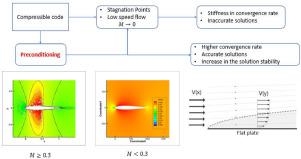当前位置:
X-MOL 学术
›
Int. J. Mech. Sci.
›
论文详情
Our official English website, www.x-mol.net, welcomes your
feedback! (Note: you will need to create a separate account there.)
Preconditioning Methods for Compressible Flow CFD Codes: Revisited.
International Journal of Mechanical Sciences ( IF 7.1 ) Pub Date : 2020-11-01 , DOI: 10.1016/j.ijmecsci.2020.105898 A.A.G. Maia , J.S. Kapat , J.T. Tomita , J.F. Silva , C. Bringhenti , D.F. Cavalca
International Journal of Mechanical Sciences ( IF 7.1 ) Pub Date : 2020-11-01 , DOI: 10.1016/j.ijmecsci.2020.105898 A.A.G. Maia , J.S. Kapat , J.T. Tomita , J.F. Silva , C. Bringhenti , D.F. Cavalca

|
Abstract The present article aims to implement and investigate a different preconditioning method based in a three-dimensional in-house compressible CFD code that ensures the robustness and numerical stability to determine the flowfield considering low Mach number flow. The present preconditioning method involve two different methodologies developed by references [8, 32]. The CFD solver was developed to calculate the Euler and Navier-Stokes equations, numerically, for steady-state regime based on the cell-centered finite volume method (FVM) using Reynolds Averaged Navier-Stokes equations (RANS). The centered second-order scheme was used for the discretization of convective terms from momentum equations. The explicit second-order five-step Runge-Kutta scheme was employed for the time-marching procedure, using an implicit residual smoothing technique to enhance the numerical stability. A local preconditioning method was implemented due to its robustness in predicting low Mach number flows in a compressible CFD code environment. However, for low Mach number flows, near stagnation points, numerical perturbations were amplified generating a stiffness in the convergence rate, which provided an inaccurate solution and numerical stability degradation. Aiming to improve the preconditioning robustness, a flux function and a new limiter were applied to operate with the preconditioning technique based on a pressure sensor. Those corrections re-scale the eigenvectors and ensure the locality of the algorithm, which improves the numerical stability and guarantees the convergence for low-speed flows. The inviscid flow over a NACA 0012 airfoil for compressible and incompressible cases shown accurate and robust solutions. For a viscous flow over a flat plate case in the compressible and incompressible cases, the preconditioning technique purposed in this work supplied good numerical solution in agreement with the analytical solution.
中文翻译:

可压缩流 CFD 代码的预处理方法:重新审视。
摘要 本文旨在实施和研究一种基于三维内部可压缩 CFD 代码的不同预处理方法,该方法可确保在考虑低马赫数流动时确定流场的鲁棒性和数值稳定性。目前的预处理方法涉及参考文献 [8, 32] 开发的两种不同的方法。CFD 求解器的开发目的是使用雷诺平均 Navier-Stokes 方程 (RANS) 基于单元中心有限体积法 (FVM) 以数值方式计算稳态体系的 Euler 和 Navier-Stokes 方程。中心二阶格式用于从动量方程离散化对流项。显式二阶五步龙格-库塔方案用于时间推进程序,使用隐式残差平滑技术来增强数值稳定性。由于其在可压缩 CFD 代码环境中预测低马赫数流的鲁棒性,因此实施了局部预处理方法。然而,对于低马赫数流,靠近停滞点,数值扰动被放大,产生收敛速度的刚度,这提供了不准确的解和数值稳定性降低。为了提高预处理的鲁棒性,应用了通量函数和新的限制器来与基于压力传感器的预处理技术一起运行。这些修正重新缩放特征向量并确保算法的局部性,从而提高数值稳定性并保证低速流的收敛。对于可压缩和不可压缩情况,NACA 0012 翼型上的无粘性流动显示了准确和稳健的解决方案。对于在可压缩和不可压缩情况下通过平板外壳的粘性流动,本工作中的预处理技术提供了与解析解一致的良好数值解。
更新日期:2020-11-01
中文翻译:

可压缩流 CFD 代码的预处理方法:重新审视。
摘要 本文旨在实施和研究一种基于三维内部可压缩 CFD 代码的不同预处理方法,该方法可确保在考虑低马赫数流动时确定流场的鲁棒性和数值稳定性。目前的预处理方法涉及参考文献 [8, 32] 开发的两种不同的方法。CFD 求解器的开发目的是使用雷诺平均 Navier-Stokes 方程 (RANS) 基于单元中心有限体积法 (FVM) 以数值方式计算稳态体系的 Euler 和 Navier-Stokes 方程。中心二阶格式用于从动量方程离散化对流项。显式二阶五步龙格-库塔方案用于时间推进程序,使用隐式残差平滑技术来增强数值稳定性。由于其在可压缩 CFD 代码环境中预测低马赫数流的鲁棒性,因此实施了局部预处理方法。然而,对于低马赫数流,靠近停滞点,数值扰动被放大,产生收敛速度的刚度,这提供了不准确的解和数值稳定性降低。为了提高预处理的鲁棒性,应用了通量函数和新的限制器来与基于压力传感器的预处理技术一起运行。这些修正重新缩放特征向量并确保算法的局部性,从而提高数值稳定性并保证低速流的收敛。对于可压缩和不可压缩情况,NACA 0012 翼型上的无粘性流动显示了准确和稳健的解决方案。对于在可压缩和不可压缩情况下通过平板外壳的粘性流动,本工作中的预处理技术提供了与解析解一致的良好数值解。











































 京公网安备 11010802027423号
京公网安备 11010802027423号